![]()
| The wall material mainly consisting of scallop shell (ChaffwallTM) features a chemical material-reducing function. The material utilizes fine powders of unburned and burned scallop shell and a natural adhesive, so harm from chemicals does not occur. |
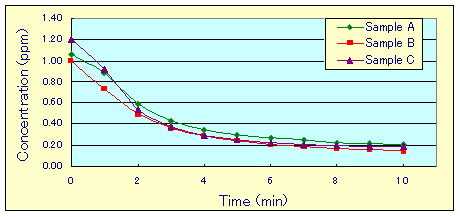 Fig.1 |
| We developed ChaffwallTM in 1996 as a wall material. It is composed of 86% scallop shell powder and 14% cellulose acetate as a binder. The effect of this wall material on the decrease in formaldehyde in the atmosphere was examined in a grove box (capacity: 140 l). The concentrations of formaldehyde were monitored using FormtectorTM (New Cosmos Electric Co., LTD., Tokyo, Japan) and a gas detector pipe (Gastec Co., Ltd., Tokyo, Japan). The powder of ChaffwallTM was applied to both sides of 5 sheets of glass plate (420 mm x 300 mm), which was wrapped in a vinyl bag and settled in the grove box. With the unbaked powder, 14% cellulose acetate was used as an agglutinant. The initial concentration of formaldehyde in the grove box was adjusted to 1 ppm, and the glass plates were exposed to formaldehyde vapor. The formaldehyde concentration in the grove box was measured every 1 min for 10 min. As is shown in Fig.1 ChaffwallTM effectively reduced formaldehyde within 10 min. The plates to which ChaffwallTM was applied were also effective even when the plates were repeatedly exposed 3 times to a high concentration (40 ppm) of formaldehyde(Fig.2) suggesting the possibility of resolving chloroform with ChaffwallTM . The durability of this wall material to reduce formaldehyde is now under investigation. |
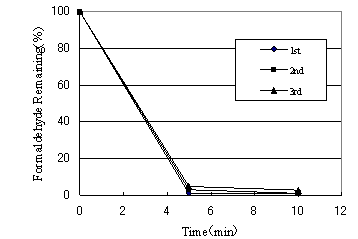 Fig.2 The initial concentration of formaldehyde is 40 ppm. |
| The deodorant action of the wall material(ChaffwallTM) didn't change at all ten years ago even if there was no peculiar hospital smell at the hospital which constructed it and passed for ten years. |
| It confirmed that hydroxyl radicals occurred from SSC as a result of
an ESR(electron spin resonance) analysis examination. SSC does the action
of the catalyst. We think that it resolves the formaldehyde due to the
following reaction formula and we confirmed hydrogen of reaction product. HCHO + H2O → 2H2 + CO2 |
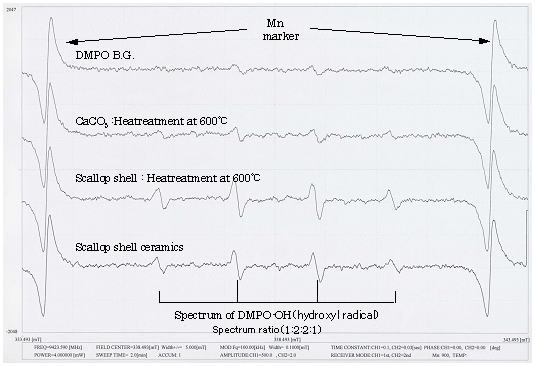 Fig.3 ESR spectrum |
| People whose houses were constructed using the wall material mentioned above reported that when they get up in the morning the odor from the previous day from such things as roasting meat or cigarettes is gone. |
| Removal of ethyl acetate by scallop shell ceramic |
| The following experiment was conducted order to examine the extent to which scallop shell ceramic can remove ethyl acetate. Scallop shell ceramic was added to a solution of water and ethyl acetate(0.5%wt) and the solution was stirred in an Erlenmeyer flask for about 120 hours with a stirrer. Changes in the concentration of ethyl acetate and pH with time were observed. The concentration of ethyl acetate decreased from 1.45% to 1.25% just after scallop shell ceramic was added and further decreased to less than 0.10% 48 hours later. In contrast, the concentration of ethyl acetate in a control flask was over 1.5% 120 hours later. Few changes in pH in these flasks were observed until the experiment was concluded. The experiment suggests that adding scallop shell ceramic to a solution of water and ethyl acetate should promote hydrolysis and decompose the solution into acetic acid and ethyl alcohol. |
| Functions of scallop shell ceramics to decompose chemical materials, destroy odors and protect against insects |
| When commercially available urethane sponge is kept in an aqueous solution of fine scallop shell ceramics powders, it completely decomposes in about a month. Therefore, the shell ceramics powder is capable of decomposing chemicals and has a potential for breaking down plastics. It is likely that it could be used for disposal of waste plastics. The photograph shows the condition 27 days after treatment. | |||
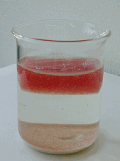 |
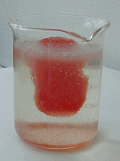 |
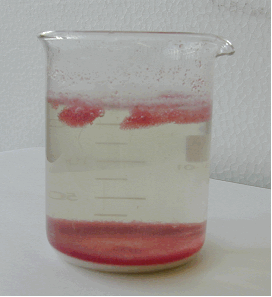 |
 |
| 20 h | 63 h | 20 days | 27 days |
| Moreover, when scallop shell is finely crushed with a hammer and scattered around the house, etc. ants do not usually come near. It is possible that it may be used to eliminate white ants. |